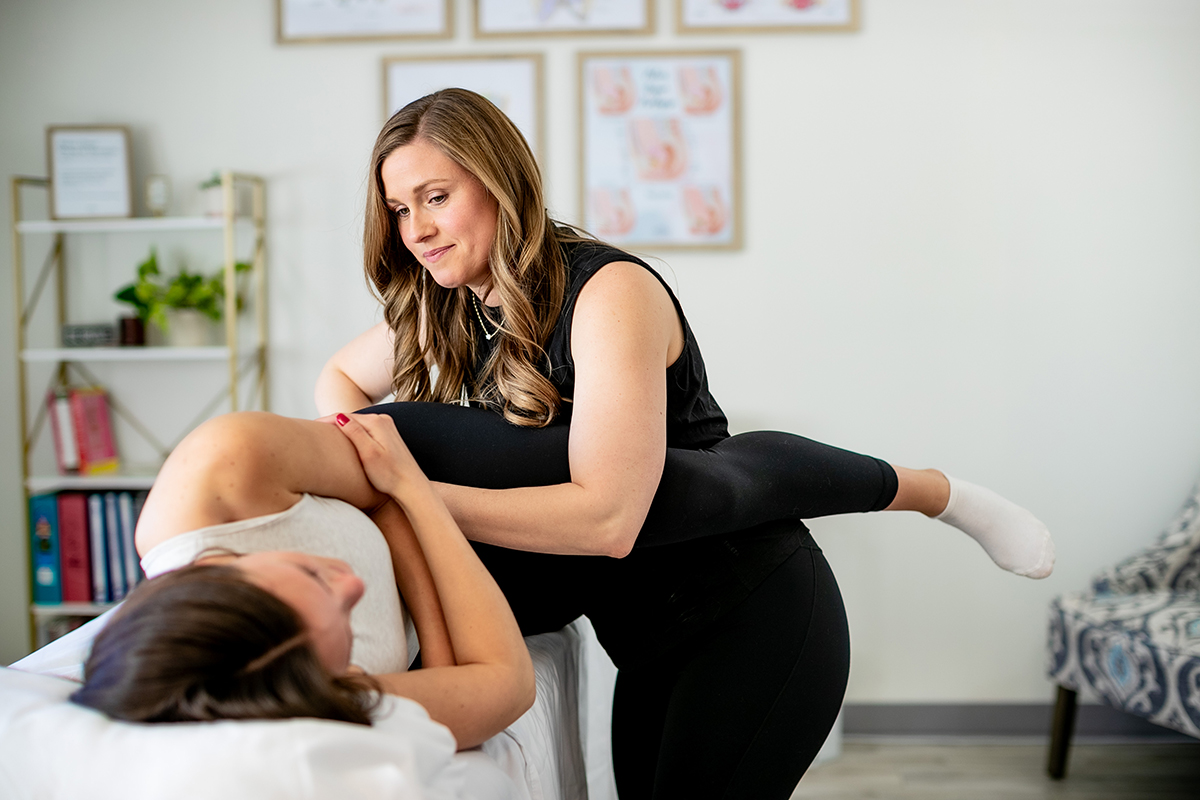
PELVIC FLOOR THERAPY
You deserve a whole person approach to pelvic health!
Pelvic floor treatment may involve an internal vaginal assessment and treatment of the muscles that make up your pelvic floor. Just like other muscles in your body, these muscles can become dysfunctional and pelvic floor therapists specialize in these cases.
ConqHER Pelvic Health supports women before, during, and after pregnancy by providing help to those experiencing:
Hip or back pain
SI joint pain
Urinary incontinence
Pelvic pain
Neck pain
Pelvic organ prolapse
Painful intercourse
Constipation
What can you expect from physical therapy at ConqHER Pelvic Health?

1:1 60-Minute Treatment
You’ll be with a doctor of physical therapy for your full 1 hour treatment session.

A Holistic Approach
Your diet, sleep, stress, and more are all factors in your healing journey.

Patient-Centered Focus
Each session and your care plan is centered around your individual wishes and goals.

Individualized Plans
No one-size-fits-all plans here. Your plan is only formed after a personal assessment.

Manual Treatments
Advanced manual treatments are beneficial for restoring balance.

Pelvic Floor Training
The treatment of your pelvic floor structures are built into your plan of care.

Prenatal Care
There are many benefits to seeing a physical therapist during your pregnancy and those benefits can even start before pregnancy. Meeting with a PT pre-pregnancy can give you guidance on preparing your body for pregnancy and all of the changes that come with it. With a PT that specializes in obstetrics, you’ll have guidance throughout your pregnancy, help preparing for labor and delivery and making a birthing plan that fits your goals, and help getting prepared for the postpartum period.
Other benefits of adding an obstetric and pelvic floor trained physical therapist to your healthcare team include:
Comfort
There’s no need to suffer through the aches and pains that sometimes come along with pregnancy. Treatments to address SI joint pain, Pubic symphysis pain, rib discomfort, hip pain, sciatica and more are available.
Education
Get help navigating the ins and outs of pregnancy. Get all of your pregnancy questions answered without the google overwhelm and feel confident throughout your pregnancy.
Labor and Delivery Planning
Help with forming the ideal birthing plan for you! Education on positioning, stages of labor, pros and cons of medications, and proper pushing techniques.
Exercise Guidance
Guidance for appropriate exercise modifications during each trimester. Feel confident in continuing your exercise and activities that you love throughout pregnancy.
Body Mechanics Training
Education on safe body mechanics for everyday activities (housework, lifting, caring for older kiddos) to reduce the risk of injury.
Postpartum Planning
Guidance on planning for the initial postpartum period. A plan for caring for yourself after baby is best made before birth.
Postpartum Care
I believe that every mom should be referred to Pelvic Floor physical therapy after giving birth. The body goes through many changes during and after your birth experience. Whether you’re newly postpartum, or years into your postpartum experience, it’s never too late to seek postpartum care! You deserve to return to feeling like yourself in your new role as mom.
The benefits of working with a physical therapist during postpartum include:
Scar Management
Cesarean scars, perineal tearing, and other birth related injuries should be treated and addressed to get you back to feeling like yourself.
Core and Pelvic Floor Recovery
Many times when moms tell me that they still don’t feel “right” after giving birth, what they are feeling is a lack of core and pelvic floor support.
Guided Return to Activities and Exercise
It’s OK and possible to return to your pre-pregnancy activities after giving birth! Get guidance on how to progress back to physical activity safely.

If you have dreams of living your life and getting back to your activities that make you YOU, free of pain, bladder leaks, or pelvic floor issues, I would be honored to be part of that journey with you!
In Network Vs. Out of Network
ConqHER Pelvic Health has strategically chosen to be a cash based physical therapy practice for the benefit of our patients. We feel that healthcare that is dictated by insurance companies is not in the best interests of patients. It prevents us from providing the quality of care we believe that you deserve. Keep reading for a peek inside the difference in care you can expect to receive between a cash based vs. an in network based PT practice.
Cash Based
- Full session times based on the most optimal treatment for your condition.
- Your therapist’s undivided attention for the entirety of your treatment sessions.
- Space to feel fully heard so that your experience and beliefs are valued by your therapist.
- A whole body based treatment approach.
- A plan of care directed towards the true driver or underlying cause of your pain and dysfunction.
- A combination of hands on treatment, mind-body training, and strengthening as part of your plan of care.
- Transparency of healthcare costs – no surprise bills that you’ll get hit with down the road!
In Network
- Session times limited by insurance payouts, which will likely lead to the need for more treatment sessions throughout your plan of care.
- Sharing your therapist’s attention with other patients during your treatment times or getting passed to assistants or aids for part of your session time.
- Rushed sessions due to high patient volumes in busy clinics.
- Treatment plans limited to treating only your symptoms, without a focus on the underlying cause.
- Passive treatments from machines in order to increase PT availability for other patients.
- Surprise bills down the road due to insurance coverage denials that your PT cannot predict.
FAQs
What conditions do you treat?
I am pelvic floor trained and specialize in helping women through the stages of pregnancy and postpartum. Several conditions may arise in pregnancy and the postpartum period including, but not limited to: SI joint pain, rib discomfort, sciatica, hip pain, pelvic pain, tailbone pain, low back pain, urinary incontinence, pelvic organ prolapse, and pain with intercourse.
You can also see a PT during pregnancy or postpartum for preventative care and guidance on forming your birthing plan and staying in / returning to your pre-pregnancy activities and exercises.
What should I expect during my first session?
The initial evaluation is a time for you to give your full account of the problem for which you’re seeking physical therapy! You’ll have a chance to tell me the full background of your condition and your goals of therapy. I will then use your reporting to direct the musculoskeletal assessment. If you’re condition is one that I believe necessitates a pelvic floor or internal vaginal assessment, I will discuss this with you and thoroughly explain what you can expect with it – it will not be performed on day 1. Should you agree to a pelvic floor or internal vaginal assessment, it will take place during a session that you are aware of ahead of time.
It’s best to wear comfortable clothes that are easy to assess movement in. Typical workout clothes work great!
What is involved in a pelvic floor evaluation and treatment?
While the pelvic floor can be vaguely assessed from the outside structures, the most thorough assessment of these muscles and structures is done internally, through the vaginal canal. This involves the PT inserting a single treating finger into the vaginal opening to assess the muscular structures for strength, coordination, tightness / laxity, and trigger points as these things relate to your symptoms.
Internal work is only done with full consent from you each time. You will also be asked each time if you would like to bring someone with you to have in the room during the assessment or treatment. Internal assessment and/or treatment will always be planned ahead of time so that you are aware you are coming to an appointment that will include internal work. Your comfort is the top priority ALWAYS, but especially during sessions that incorporate internal work.
Do I have to have my pelvic floor treated internally to get better?
Nope! There are many conditions in which the pelvic floor muscles play an integral role. In those cases, the pelvic floor can be vaguely assessed without the internal aspect. We can then address the dysfunctions that we find, to a certain extent.
However, in order to get the best assessment of the state of the muscles and tissues of the pelvic floor, an internal evaluation and (sometimes) treatment is optimal and will provide more complete benefits.
When is the best time to see a PT if I want to get back to exercising postpartum?
Before giving birth! I like to think of this as “prehab,” just like you hear about people doing before a big knee or shoulder surgery.
The best time to learn connection with your core and pelvic floor is before it goes through labor and delivery.. Then, in the postpartum period, you’ll have a much better grasp on what correct connection and coordination of these muscles should feel like.
Also, research shows that women who participate in core and pelvic floor training early in pregnancy are less likely to have complications after birth like urinary incontinence or pelvic organ prolapse. This means that you’ll be setting yourself up for an easier and most likely faster recovery back to your pre-pregnancy exercise routine!
Do I need a referral from my doctor?
Nope! Colorado is a direct access state, meaning that you do not need a physician’s referral to receive treatment from a physical therapist.
In specific cases, I may call your physician to ensure that certain treatment procedures are safe for you before providing treatment.
